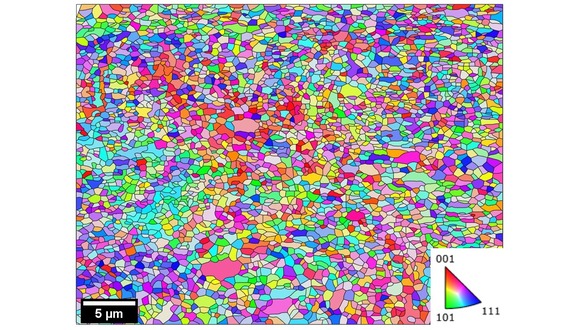Tue, 25 November, 2025
A new paper, co-written by experts from TWI and academia, has been published by the journal of Materials Science and Engineering A.
The paper, ‘Irradiation Damage and Powder Quality Impact on the Strength of Hot Isostatically Pressed ODS Ferritic Steel,’ was co-authored by Alice Appleby, Liam Hughes, Yu Lung Chiu and Moataz M Attallah from the University of Birmingham’s School of Metallurgy and Materials along with Eleanor Teather from Imperial College London’s Department of Materials, and TWI Consultant Raja Khan.
Oxide dispersion strengthened (ODS) ferritic steels are of interest to the nuclear industry for their resilience at high temperatures, strength, and resistance to irradiation-induced defects.
The structural properties of ODS ferritic steels, and in particular their creep resistance, are predominantly dependent on the optimal distribution of yttrium-based nano-oxides, which are typically incorporated into the matrix through powder metallurgy processes, such as mechanical alloying (MA) and powder atomisation. Gas atomisation reactive synthesis (GARS) has been developed as an alternative to MA, but its application to aluminium (Al)-containing alloys has not been comprehensively understood.
The addition of Al has been found to form Y-Al-oxides, such as YAlO3 (YAP), Y3Al5O15 (YAG) and Y4Al2O9 (YAM). PM2000 (Fe-20 wt%Cr-5wt%Al-0.5 wt%-0.5Y2O3) ferritic stainless-steel powder was produced through typical MA and GARS production methods, and both powders were consolidated by the powder metallurgy hot isostatic pressing (PM HIP) process.
 EBSD image of the cross-section ODS GARS powder
EBSD image of the cross-section ODS GARS powder
 EBSD image of hot isostatically pressed (HIP’d) GARS powder
EBSD image of hot isostatically pressed (HIP’d) GARS powder
The powders were then characterised to determine physical and chemical properties. The mechanical properties of PM HIP ODS consolidated materials were determined to understand the effect of the particle strengthening through structural property modelling.
This study was conducted to develop the understanding of oxide formation in the powder, as-hot isostatically pressed (HIP’d) and as-proton irradiated conditions.
The paper demonstrates how our experts work with both industry and academia to advance engineering processes and deliver new solutions. You can see the paper, in full, here:
https://doi.org/10.1016/j.msea.2025.149436
 Alice Appleby with TWI's Raja Khan
Alice Appleby with TWI's Raja Khan